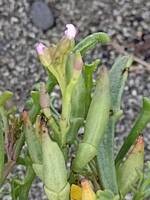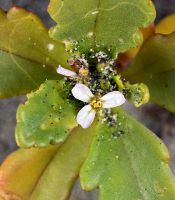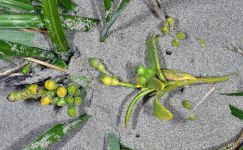Distribution: Occurring west of the Cascades crest in coastal counties in Washington; Alaska to California along the coast, native to the Great Lakes region and coastal eastern North America.
Habitat: Along marine water shorelines in sand or gravel.
Flowers: May-October
Origin: Introduced from eastern North America
Growth Duration: Annual, Biennial, Perennial
Conservation Status: Not of concern
Pollination: Bees, flies, butterflies
Glabrous, fleshy annual, the stems freely-branched, decumbent at the base, 1-5 dm. tall.
Leaves alternate, 2-7 cm. long, the blade oblong-ovate to oblong-oblanceolate, deeply scalloped to wavy-serrate, narrowed to a broad petiole.
Flowers in racemes 4-15 cm. long; pedicles stout, 3-7 mm. long, ascending; sepals 4, 3-4 mm. long, with a few soft hairs at the tip, soon deciduous; petals 4, white to purplish-tinged, long-clawed, 6-8 mm. long; stamens 6; style none.
Siliques fleshy, 1.5-2.5 cm. long, 2-jointed, the lower segment cylindric and persistent, the upper segment ovoid-quadrangular and deciduous, narrowed to a truncate beak, each segment 1-seeded or the lower segment seedless.
Publication: Fl. Bor.-Amer. 1: 59. 1830.
-
var. edentula – American sea-rocket
 Occurring west of the Cascades crest in coastal counties in Washington; Alaska to California along the coast, native to the Great Lakes region and coastal northeastern North America.
Occurring west of the Cascades crest in coastal counties in Washington; Alaska to California along the coast, native to the Great Lakes region and coastal northeastern North America.
PNW Herbaria: Specimen records of Cakile edentula in the Consortium of Pacific Northwest Herbaria database
WA Flora Checklist: Cakile edentula checklist entry
OregonFlora: Cakile edentula information
E-Flora BC: Cakile edentula atlas page
CalPhotos: Cakile edentula photos






































